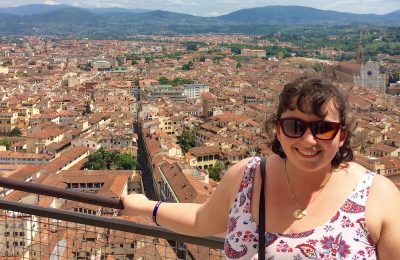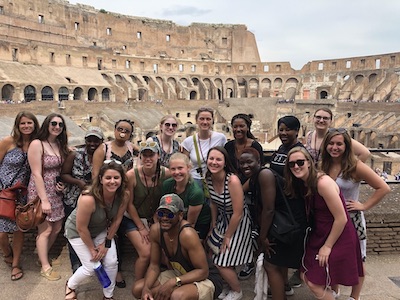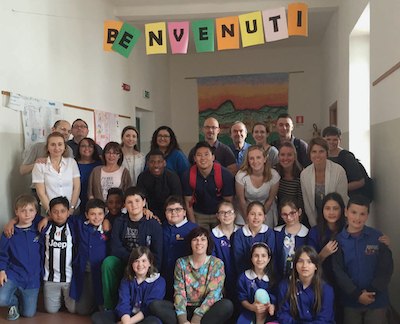Now a doctoral student researching inclusive education, Sara Jo Soldovieri ’18, G’19 was a sophomore when she took “Literacy, Inclusion, and Diversity in Italy,” a study abroad short course offered by the Syracuse University School of Education and Syracuse Abroad.

Soldovieri matriculated at Syracuse because of her interest in inclusive education and the University’s deep expertise in the subject. Studying abroad in Italy showed her the possibilities of fully integrating students with disabilities into the classroom. It helped set Soldovieri on her academic path.
A Program Re-Imagined
“A beneficial piece of the trip was seeing inclusion in action in a way we don’t see in the United States,” says Soldovieri. “While Italy is not perfect, for students with disabilities to be fully included in classrooms and to see that work was really important for me. It was not just a utopia—inclusion really exists.”
“Literacy, Inclusion, and Diversity in Italy” was originally developed more than 20 years ago by Professor Carol Berrigan, one of many inclusive education pioneers who have associated with Syracuse over the years. In 2014, the program was re-imagined by professors Christine Ashby, Beth Ferri, and Kathleen Hinchman. Now Associate Provost for Strategic Initiatives, Marcelle Haddix also joined the team in 2016.
“We turned it into a co-taught program, led by faculty in both literacy and disability studies, with faculty swapping out duties year by year,” explains Ashby. The last trip before the coronavirus pandemic was in 2018, when 16 students traveled abroad. The program returns between May 16 and June 1, 2022, with 12 students signed up.

As in years past, students will stay part of the time in Florence—home to Villa Rossa, the Syracuse Center—visiting schools and cultural sites and spending a day in Venice. They will also visit Rome for a week to continue their study of Italian disability and inclusion history and policies.
Air of Joyfulness
Before Florence and Rome, the students begin the short course in Italy’s Marche Region and the picturesque village of Coldigioco. This hilltop community already has a Central New York connection. It is known worldwide for its Geological Observatory, an interdisciplinary research center bringing together geology, art, and cuisine, co-founded by Syracuse-born artist Paula Metallo.
While School of Education students stay in the village, they perform literacy projects and observe fully inclusive schooling in the nearby town of Apiro. That’s the part of the trip that made a profound impression on Soldovieri.
“I remember seeing a student with noticeable physical disability and complex support structures—augmented communication and a wheelchair—being fully included in a science lesson,” recalls Soldovieri. “I could tell from the way the other students were interacting that this wasn’t just a show for the Americans. There was an air of joyfulness about these students. I thought, this is the energy I want in my classroom.”
“Thinking about my time at Syracuse—and then back to Italy—everything I do centers on the idea that there is going to be no progress to fix our unjust educational system unless we get rid of our current special education system and introduce disability supports in general education.”
“Italy has some of the world’s most progressive policies supporting inclusive practice,” explains Ashby. This fact—as well as the country’s current engagement with profound societal changes, such as immigration, which directly affect educational policy—make Italy an excellent site of study for US-based education students.
Wild Inclusion

Italy chose a robust inclusive education policy as part of its rebuilding and renewal after the fascist government of the 1930s and 1940s and the devastation of World War II. “Italy’s ‘Period of Wild Inclusion’ started in 1971,” Ashby says. “The country’s rebuilding was partly done through inclusion, with all disabled kids going to regular schools. The idea was that school is a family, and we should all be in a community and look after each other.”
When introduced in the Seventies, Italy’s policy of mainstreaming students with disabilities went much further than US special education policy. Although policy changes have brought Italy closer to the US model, the Italian education system nonetheless inspired Soldovieri, who calls for wholesale changes to special education in her home country.
“Thinking about my time at Syracuse—and then back to Italy—everything I do centers on the idea that there is going to be no progress to fix our unjust educational system unless we get rid of our current special education system and introduce disability supports in general education,” Soldovieri says, explaining her current research.
“We don’t need a separate system for students with disabilities,” Soldovieri continues. “In Italy, those students were getting exactly what they need without any ‘special’ education. I’ve framed my scholarship around this idea, and I might not have had that idea without my experience abroad.”
A Mixed Cohort
Graduating with a bachelor’s degree in 2018, Soldovieri then took a master’s degree in Inclusive Special Education (Grades 7-12) before moving into the Ph.D. program. She says she would consider returning to Italy as a doctoral student, taking advantage of a unique aspect of the short course.
“We bring students ranging from first year undergrads—often from the Inclusive Elementary and Special Education program—to Ph.D. students ready to defend their dissertations,” Ashby observes.
Having a mixed cohort benefits the younger students who are just being introduced to the wide range of topics covered by the course—literacy, diversity, inclusion, and disability studies. “The grad students are encouraged to mentor the undergraduates, but often the mentoring happens naturally,” adds Ashby.
“There was a lot of willingness by the grad students to support and push the undergrads and to help with difficult readings,” recalls Soldovieri. “I thought, the grad students don’t have to do this, but that’s just part of the culture at the School of Education.”
Learn more about School of Education’s Study Abroad programs, as well as Himan Brown Fellowships to support study abroad experiences.
